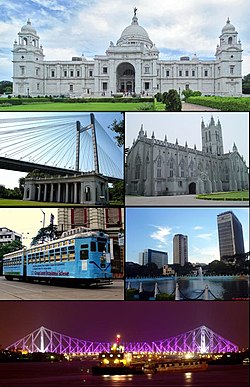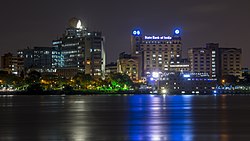Kolkata
Kolkata (spelled Calcutta before 1 January 2001) is the capital city of the Indian state of West Bengal. It is the second largest city in India after Mumbai.[2] It is on the east bank of the River Hooghly.[3] When it is called Calcutta, it includes the suburbs. This makes it the third largest city of India. It is also known as city of joy It has 4,500,000 (4.5 million) people living in it. This also makes it the world's 8th largest metropolitan area as defined by the United Nations.[4] Kolkata served as the capital of India during the British Raj until 1911. Kolkata was once the center of industry and education. However, it has witnessed political violence and economic problems since 1954. Since 2000, Kolkata has grown due to economic growth. Like other metropolitan cities in India, Kolkata struggles with poverty, pollution and traffic congestion.
|
কলকাতা कोल्काता Calcutta | |
|---|---|
Megacity | |
 | |
|
| |
| Coordinates: 22°34′22″N 88°21′50″E / 22.57278°N 88.36389°ECoordinates: 22°34′22″N 88°21′50″E / 22.57278°N 88.36389°E | |
| Country | India |
| State | West Bengal |
| Division | Presidency |
| District | Kolkata[1] |
| Government | |
| • Type | Mayor–Council |
| • Mayor | Firhad Hakim (TMC) |
| Area | |
| • Megacity | 185 km2 (71 sq mi) |
| • Metro | 1,886.67 km2 (728.45 sq mi) |
| Elevation | 9 m (30 ft) |
| Population (2011) | |
| • Megacity | 4,486,679 |
| • Rank | 7th |
| • Density | 24,250/km2 (63,200/sq mi) |
| • Metro | 14,112,536 |
| • Metro rank | 3rd |
| • Demonym | Calcuttan |
| Time zone | UTC+05:30 (IST) |
| Postal index number | 7000 xx, 7001 xx |
| Vehicle registration | WB 01–79 |
| UN/LOCODE | IN CCU |
| Telephone | 91-33-XXXX XXXX |
| Spoken languages | Bengali, Nepali, English |
| Ethnicity | Bengali, Marwari, Bihari, Other |
| Website | www |
History

The discovery of the nearby Chandraketugarh,[5] an archaeological site has proved that people have lived there for over two millennia.[6] The history of Kolkata begins when the English East India Company arrived in 1690. Job Charnock, an administrator with the company is traditionally known as the founder of this city.[7] However some academics say that Charnock is not the city's founder.[8]
At that time Kolkata, ruled by the Nawab of Bengal Siraj-Ud-Daulah, had three villages. They were Kalikata, Govindapur and Sutanuti. The British in the late 17th century wanted to build a fort near Govindapur. This was to become more powerful than Dutch, the Portuguese, and the French. In 1702, the British completed the construction of old Fort William,[9] which was used to station its troops and as a regional base. Calcutta was declared a Presidency City, and later became the headquarters of the Bengal Presidency.[10] When regular fights with French forces started, in 1756 the British began to upgrade their fortifications. When this was protested, the Nawab of Bengal Siraj-Ud-Daulah attacked and captured Fort William. This led to the infamous Black Hole incident.[11] A force of Company sepoys and British troops led by Robert Clive recaptured the city the next year.[11] Calcutta became the capital of British India in 1772,. However, the capital shifted to the hilly town of Shimla during the summer months every year, starting from the year 1864.[12] Richard Wellesley, the Governor General between 1797 and 1805, helped in the growth of the city and its public architecture. This led to the description of Calcutta as "The City of Palaces".[13] The city was a centre of the British East India Company's opium trade during the 18th and 19th century; locally produced opium was sold at auction in Kolkata, to be shipped to China.[14]
Kolkata Media
Ships of the British East India Company near Fort William in the Port of Calcutta in 1735
Tipu Sultan Mosque in 1945
Kolkata from space captured by Copernicus Sentinel-2.
- Kolkata Skyline pic.jpg
Aerial view of Kolkata with the Hooghly River
Park Street, one of the posh areas in Kolkata
Tata Steel building in Kolkata CBD
References
- ↑ The Kolkata metropolitan area also includes portions of North 24 Parganas, South 24 Parganas, Howrah, Nadia, and Hooghly districts. See: Urban structure.
- ↑ "National Portal of India : Know India : State and UTs". Archived from the original on 2011-01-27. Retrieved 2009-07-07.
- ↑ The Monthly Repository and Library of Entertaining Knowledge. Francis S. Wiggins. 1833. p. 338.
- ↑ "World Urbanization Prospects: The 2005 revision" (PDF).
- ↑ "History". Yahoo! Pte Ltd. Archived from the original on 2006-05-23. Retrieved 2006-05-08.
- ↑ Das S (2003-01-15). Pre-Raj crown on Clive House- Abode of historical riches to be museum. The Telegraph, Kolkata, India. http://www.telegraphindia.com/1030115/asp/frontpage/story_1575128.asp. Retrieved 2006-04-26.
- ↑ "Kolkata: History" (in Bengali and Nepali). Calcuttaweb.com. Archived from the original on 2007-05-10. Retrieved 2007-02-18.
{{cite web}}: CS1 maint: unrecognized language (link) - ↑ Gupta, Subhrangshu (18 May 2003). "Job Charnock not Kolkata founder: HC Says city has no foundation day". Nation (The Tribune). http://www.tribuneindia.com/2003/20030518/nation.htm#3. Retrieved 2006-12-07.
- ↑ "William, Fort". Encyclopædia Britannica. 2007. Retrieved 2007-09-01.
- ↑ "Calcutta". Encyclopædia Britannica. 1911. Retrieved 2007-09-18.
- ↑ 11.0 11.1 "History of Kolkata". Kolkathub.com. Archived from the original on 2007-08-13. Retrieved 2007-09-04.
- ↑ Chuahan, Baldev (7 August 2007). Shimla - more than just Raj nostalgia. The Indian Star. http://www.theindianstar.com/index.php?udn=2007-12-02&uan=1197. Retrieved 2009-03-08.
- ↑ Dutta, Krishna. "Calcutta; A Cultural and Literary History". Interlink Books. Archived from the original on 2006-05-08. Retrieved 2007-10-11.
- ↑ Pati, Biswamoy (2006). "Narcotics and empire". Frontline. The Hindu. 23 (10). Archived from the original on 2007-11-02. Retrieved 2007-09-04.
Other websites
![]() Media related to Kolkata at Wikimedia Commons
Media related to Kolkata at Wikimedia Commons![]() Kolkata travel guide from Wikivoyage
Kolkata travel guide from Wikivoyage







